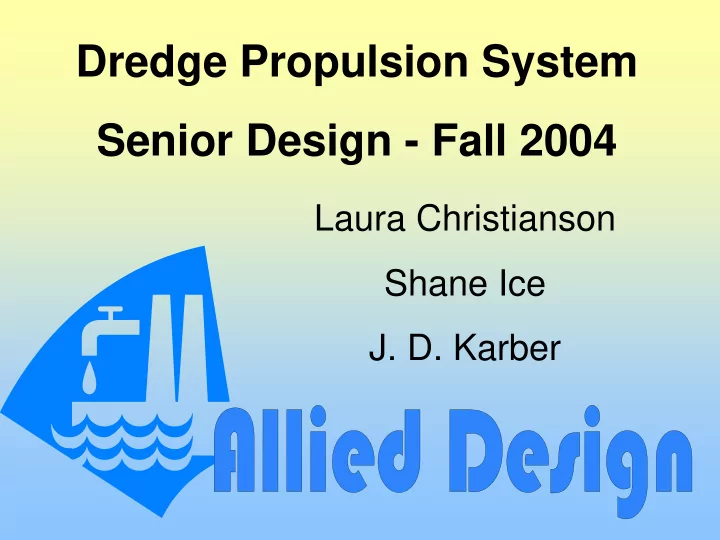

Dredge Propulsion System Senior Design - Fall 2004 Laura Christianson Shane Ice J. D. Karber
Sponsor • Sponsored by VMI of Cushing, Oklahoma • Represented by Cash Maitlen • Offers over 30 years of dredge manufacturing experience • Manufactures, rents, and sells dredging equipment and accessories
How do Dredges Work? • Overtime, water bodies such as lakes and rivers may receive sediment due to erosion. • A cutterheads lowers, by way of a boom, into the sediment. • The cutterhead spins and mixes large quantities of water with the excavated material to create a slurry. • This slurry is then pumped out of the water body.
Current Propulsion Design • Current design consists of a cable and winch system • Requires cable anchors on the banks or in the water • Limits mobility and the advancement of the anchors is time consuming
Problem Statement Design of a cableless dredge propulsion system for light duty dredges for use in marinas, lagoons, and small lakes.
Patent Search Existing propulsion systems: • Starwheel • 5,782,660 • Track • 4,713,896 • 5,970,634 • 6,755,701
Design Concepts • Track System • Paddle/Cage Wheel System • Auger System
Design Concepts Track System Dual rubber tracks Pros: • Large surface area in contact with bottom Cons: • Sinking of tracks in unstable bottom
Design Concepts Paddle/Cage Wheel System Rubber tires with caged paddles on side Pros: • Traction of tires plus force from paddles Cons: • Total submergence of paddle wheel
Design Concepts Auger System Dual screw type augers Pros: • Force provided by the dredging material Cons: • Possible limited control when operating perpendicular to an incline
Placement of System • Placement of the propulsion system will play a key role in the selection of the final design • Placement Configurations • Within path of cutter head • Outside the width of cutter head
Considerations Several considerations will have to be kept in mind for design. • Cost of fabrication • Functionality with existing product • Mobility effectiveness • Operational versatility • Terrain
Testing of Materials Various tests were conducted on several materials suspect to dredging. Type of materials tested: Types of tests: • River sand • Viscosity • Swamp • Clay • Stress/Strain • Fly ash • Swine effluent • Silica
Testing of Materials Viscosity Testing Purpose for test: • Resistance on propulsion system • Propulsion created by material’s resistance to motion
Testing of Materials Viscosity Testing Disturbed Viscosity's of Dredged Materials 10 Silica 8 Swamp Shear (N*s/m 2 ) Clay 6 Swine Lagoon 4 2 0 0 5 10 15 20 25 RPM
Testing of Materials Shear Testing Purpose for test: • Resistance on propulsion system • Power required to “push” cutterhead through material
Testing of Materials Shear Testing Stress vs. Strain Curves for Dredged Material 0.4 Stress (N/cm 2 ) 0.3 Sand 0.2 Silt 0.1 Lagoon Sludge 0 0 5 10 15 20 25 30 35 Strain (mm/mm)
Prototype Testing Design • Each design concept will be fabricated. • 1/10 scale model of vessel • Propulsion systems to a similar scale
Prototype Testing Propulsion Testing • Large tank with desired material on bottom used to simulate sediment • Load cell attached to each propulsion system • Measure the traction, resistance and/or the force to “drive” or propel through the material
Proposed Budget Amount Purchase Item Cost Necessary Date Small submersible motors and various 2/1/2005 $500 mechanical parts for fabrication of models Metal for fabrication various 2/1/2005 $100 Rubber tracks 4 2/1/2005 $100 Augers 4 2/1/2005 $100 Tires 4 2/1/2005 $100 Testing Tank 50 gallon 3/1/2005 $100
Project Schedule • Fall Semester: • Patent Search • Preliminary Testing • Design Concepts • Spring Semester: • Order Parts • Model Fabrication • Model Testing • Final Recommendation
Thank You We would like to thank: • VMI • the Biosystems Engineering department A special thanks goes to: • Cash Maitlen • Dr. Paul Weckler • Dr. Glen Brown • Dr. Dani Bellmer • Dr. Doug Hamilton
Questions
Recommend
More recommend